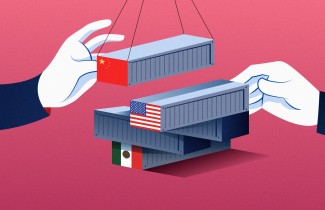The Virtuous Circle of Supply Chains and Nearshoring
Logistics will be playing an increasingly prominent role in the competitiveness of all industries

The arrival of investments resulting from nearshoring could accelerate Mexico's industrial development. However, our country continues to face supply chain challenges that need to be addressed to clear the way for this growth. These challenges are mainly divided into service level and delivery logistics, supply, transportation, and logistics costs, as shown in the First National Study on Logistics Indicators, conducted by the #SoyLogístico Association in conjunction with Logística de México and EGADE Business School.
The publication of this study is highly relevant since, until now, unified criteria for the analysis of logistics indicators in Mexico had been nonexistent. The study, which is the result of an online survey of more than 150 logistics managers and experts, measures the key points for evaluating and improving supply chains in our country.
Customer service level and delivery logistics indicators
During the Covid-19 pandemic, companies were forced to evolve their operations in response to an unexpected crisis that disrupted supply chains. By 2022, despite the challenges involved, the customer service level had returned to its former high standards, with an elevated fill rate indicator –which measures the proportion of customer orders fulfilled– across almost every sector. This reflects the emphasis placed by the logistics industry on agility, flexibility, risk mitigation, and continuous improvement, serving as a strong ally of companies in other industries, especially e-commerce.
However, according to the study, the perfect order delivery indicator was not that high, revealing a slowdown in production due to the shortage of semiconductor chips. Another challenge since 2022 has been employee turnover in the sector: compared to 8% in manufacturing, turnover in the logistics industry remains high at 27%. This can be explained by nearshoring opportunities, which have led to increased competition for talent.
Supply indicators
On top of the Covid-19 health contingency came the crisis due to the war in Ukraine. The supply chain had gradually been recovering, revealing the importance of focusing strategies on suppliers and sourcing. Being flexible with payment terms or contractual requirements, supporting supply chain monitoring and traceability, responding with real-time corrective actions, and eliminating excessive bureaucracy at control points are just some of the measures that have contributed to achieving profitable growth.
In supply indicators, sectors such as retail and manufacturing performed with high fill rate percentages, as well as variations in delivery times and delivery days according to their annual billing. Companies displayed healthy levels of annual inventory turnover, i.e., their capacity to generate sales from their inventory is agile and efficient. Optimizing warehouse occupancy is also important, which is why trends such as cubic storage continue to expand in Mexico.
Transportation indicators
There has been a post-pandemic boom in outsourced transportation. The main reasons for this include a greater cost control, optimized transport units, and increased delivery efficiency. This trend of partnering with transportation providers will continue to rise, considering key points such as collection and delivery zones and frequency, transfer times, vehicle availability, and loading capacity, among others.
Given the importance of on-time delivery, the focus on investment in transportation, route agility and delivery times must be maintained, either through own or outsourced transportation.
Financial indicators
Distribution and transportation are the cause of the rise in logistics costs. Although an increasing number of companies are developing strategies for enhancing their transportation cost control, the challenge is to find a balance between investment in infrastructure and expected performance. In this sense, it would be a good idea to consider alliances with specialized suppliers that are one step ahead in innovating in delivery consolidation. The trend of outsourcing and diversifying transportation services will continue so as to reduce transportation times and costs in nearshoring, with a special emphasis on the automotive industry.
Operations derived from distribution, such as the demand for industrial parks, storage and inspection, will also require greater investment with nearshoring, while the demand for private security and cybersecurity services will grow as well.
The challenges of the future
The greatest challenge for logistics in Mexico is undoubtedly supply chain optimization. Managers must continue to anticipate events that will interrupt its optimal performance and respond immediately to bottlenecks. The competitiveness generated by nearshoring will require the continuous improvement of routes, flexibility and real-time monitoring of deliveries, as well as increased data reading and integration for decision making. Moreover, infrastructure and service conditions must be improved to guarantee more competitive logistics costs, together with the use of emerging technologies to enhance the performance of the entire chain.
Mexico is the gateway to the largest market in the world, with the nearshoring trend and the growth in demand underscoring the geopolitical advantages of our country. Over the coming years, logistics will continue to play a leading role and gain relevance for the competitiveness of each and every industry, which is why monitoring supply chain indicators will be a crucial reference point for its continuous improvement.
The author is national director of MBA Programs at EGADE Business School.



